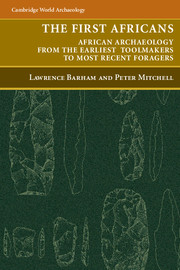Book contents
- Frontmatter
- Contents
- List of Figures and Tables
- Acknowledgements
- THE FIRST AFRICANS
- 1 Introducing the African Record
- 2 Frameworks in Space and Time
- 3 First Tool-Users and -Makers
- 4 Early Pleistocene Technologies and Societies
- 5 Mid-Pleistocene Foragers
- 6 Transitions and Origins
- 7 The Big Dry: The Archaeology of Marine Isotope Stages 4–2
- 8 Transitions: From the Pleistocene into the Holocene
- 9 Hunting, Gathering, Intensifying: The Mid-Holocene Record
- 10 Foragers in a World of Farmers
- 11 The Future of the First Africans' Past
- Notes
- Glossary
- References
- Index
5 - Mid-Pleistocene Foragers
Published online by Cambridge University Press: 05 June 2012
- Frontmatter
- Contents
- List of Figures and Tables
- Acknowledgements
- THE FIRST AFRICANS
- 1 Introducing the African Record
- 2 Frameworks in Space and Time
- 3 First Tool-Users and -Makers
- 4 Early Pleistocene Technologies and Societies
- 5 Mid-Pleistocene Foragers
- 6 Transitions and Origins
- 7 The Big Dry: The Archaeology of Marine Isotope Stages 4–2
- 8 Transitions: From the Pleistocene into the Holocene
- 9 Hunting, Gathering, Intensifying: The Mid-Holocene Record
- 10 Foragers in a World of Farmers
- 11 The Future of the First Africans' Past
- Notes
- Glossary
- References
- Index
Summary
The evolution of Homo erectus as a large-bodied, large-brained, tool-dependent hominin with extended social networks and life history took place in concert with large-scale shifts in Africa's climate. The increased variability and aridity experienced between 1.8–1.6 mya altered the continent's biogeography, creating the ecological conditions for genetic selection, behavioural innovation, and speciation. This chapter reviews the impact of a subsequent and more prolonged shift in the earth's climate that began about 1 mya and ended ~400 kya with the establishment of the current rhythm of extended glacial cycles lasting 100,000 years. The mid-Pleistocene transition led to greater climatic variability and instability, with direct effects on the distribution and predictability of the resources on which hominins depended. The poor fossil and archaeological record for this period limits our current perception of evolutionary trends, whether linked ultimately to fluctuations in climate or with their own internal dynamics (Foley 1994).
We review in some detail the climatic record for this 600,000-year interval to establish the broad patterns of biogeographical change with which to search the archaeological record for correspondences of change. Correlations are noted between mid-Pleistocene climate change and indirect evidence for the emergence of language, with increased group size and brain size seemingly linked. A speciation event at 0.6 mya marked the appearance of large-brained Homo heidelbergensis, a descendant of H. erectus and a possible ancestor of modern humans in Africa and Neanderthals in Eurasia.
- Type
- Chapter
- Information
- The First AfricansAfrican Archaeology from the Earliest Toolmakers to Most Recent Foragers, pp. 159 - 200Publisher: Cambridge University PressPrint publication year: 2008



